Interview with the Curator: III at the Art Gallery of Regina
July 8, 2025
Hooria Rajabzadeh interviews curator Sandee Moore about the exhibition III at the Art Gallery of Regina. III featured the work of Deborah Potter, Leesa Streifler, and Sheila Nourse, and ran from January 23 to March 29, 2025.
 Installation view of III at Art Gallery of Regina, 2025. Photo: Don Hall.
Installation view of III at Art Gallery of Regina, 2025. Photo: Don Hall.How did you navigate curating without flattening or generalizing the artists' voices under a unifying narrative about aging and womanhood?
SM: Actually, my approach is always to start with the artist and the artwork. I don’t begin with an idea for an exhibition and then find artists to fit into it. Instead, I do a lot of research, which includes studio visits, looking at artworks, and talking to artists. From that process, I begin to form ideas for exhibitions.
Over the last few years, during studio visits, I noticed that many artists—especially women—have been making work about aging and caregiving. Often, these women are having a dual experience: they are postmenopausal themselves, and at the same time, they are caring for their elderly parents in their final years. They are creating artwork about those experiences.
Because I saw that happening, it gave me the idea to put together an exhibition on this theme. I believe both of these experiences—aging and caregiving—are difficult, and that we can understand and process them differently. Sometimes, all people want to know is that they are not alone in these experiences. That’s part of what art can offer—connection, empathy, and recognition.
That’s how I came to the idea for the exhibition, and I always want the artist's voice to come through. I very deliberately selected artists who approach the topic of aging and elderly women from very different perspectives. That’s also one of the reasons I like to curate group exhibitions—because they allow for many facets of an issue or experience to be explored through different artists’ works.
For example, Leesa Streifler work in the exhibition III was largely inspired by her experience caring for her elderly mother, as well as her reflections on her own aging body. In contrast, Sheila Nourse’ work focused on celebrating women over 50 who had made a difference in her life and in the world. What interested me especially about Sheila’s perspective—particularly in terms of representation and identity—was that she didn’t create images of what these women looked like. Instead, she created assemblage sculptures made from items and materials that represented the things these women cared about, the activities that gave their lives meaning.
These sculptures became almost like archaeological artifacts—evidence of a life lived, accumulated through time. That way of representing aging and experience was deeply moving and offered a very different approach from the others in the show.
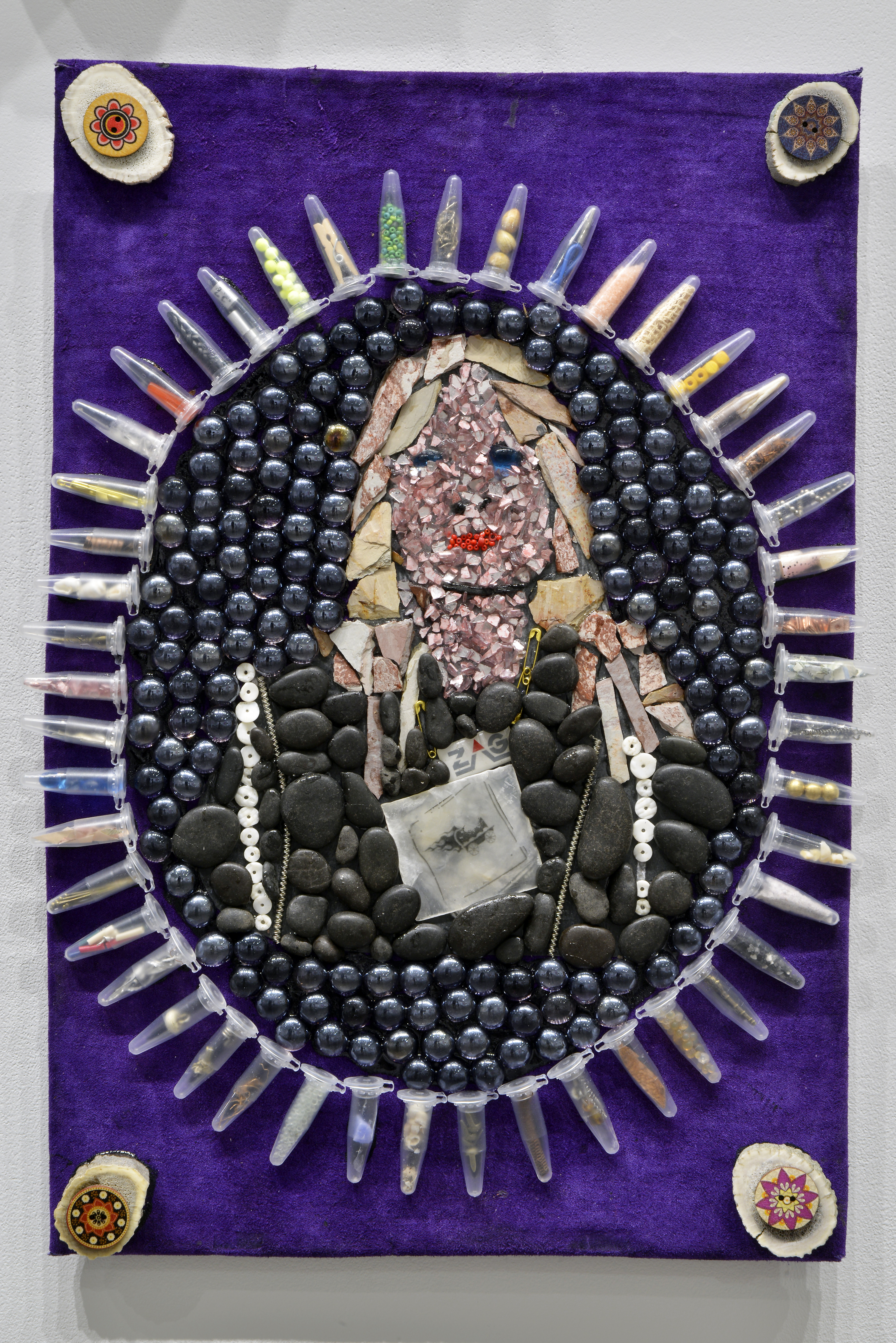
Golden Salon Series detail: Purple Warrior (Judy), Sheila Nourse, mixed media, 12.5 x 18.5", 2024. Photo: Don Hall.
Were there any moments in your curatorial work, when you choose to withhold interpretation to allow ambiguity, or even discomfort, to remain in the encounter between viewer and artwork?
SM: Yeah, that’s an interesting question. Certainly, my feeling—or my approach—is that I don’t want to force my interpretation onto anyone. I don’t want to impose it on either the artist or the audience. For the artist, their work may mean something different to them, or the goal they have in communicating it may differ from how I interpret it. And with the audience, I want to leave space for their own interpretations as well.
I think my approach is to offer different levels of engagement. If people want more, they can easily access it. For example, at the gallery, I write an exhibition didactic panel that is under 300 words. It provides an overview—just the big, overarching idea of the exhibition.
Then, we have a self-guided tour pamphlet, which includes three or four questions that point out one or two individual works. For example, one of the questions in the III exhibition focused on how the artists use scale differently. Deborah’s work consisted of miniature sculptures, which made us sense the vulnerability of older and elderly people. Leesa Streifler’s works were enormous, evoking the power and presence of women who, although often disempowered, can still have a huge impact through their actions. So that’s another layer of interpretation we offer—optional and open-ended.
The final level is the exhibition’s audio tour, which guides people through each artwork in more depth. Even with that, my approach is to ask questions and help viewers understand how to interpret a work of art, rather than telling them what it means. The example I gave from the self-guided pamphlet is a good one—we start with questions. We explore how artwork can mean more than just what it represents. Elements like the material, the artist’s choice of medium, the scale, the composition—whether it’s tidy or messy—all contribute to the feeling or "vibe" of the work.
People can often sense the artist’s intention, even if they don’t consciously articulate it. For instance, they may not say, “She used a small scale to make me feel this figure is vulnerable or insignificant in society,” but they will start to associate things with smallness. In Deborah’s work, her choice to use ceramic figurines brings up associations for many people—familiar, fragile, domestic—and that contributes to their personal interpretation.
H: So it’s like you give the audience the tools, and you leave the interpretation to them?
SM: Yes, my ultimate goal is to give people the tools to interpret artwork for themselves using the elements of art. That’s one of my real pleasures as a curator—to help people discover that art can have meaning in their lives and resonate with their experiences, so that they can understand it. It’s not an elite activity.
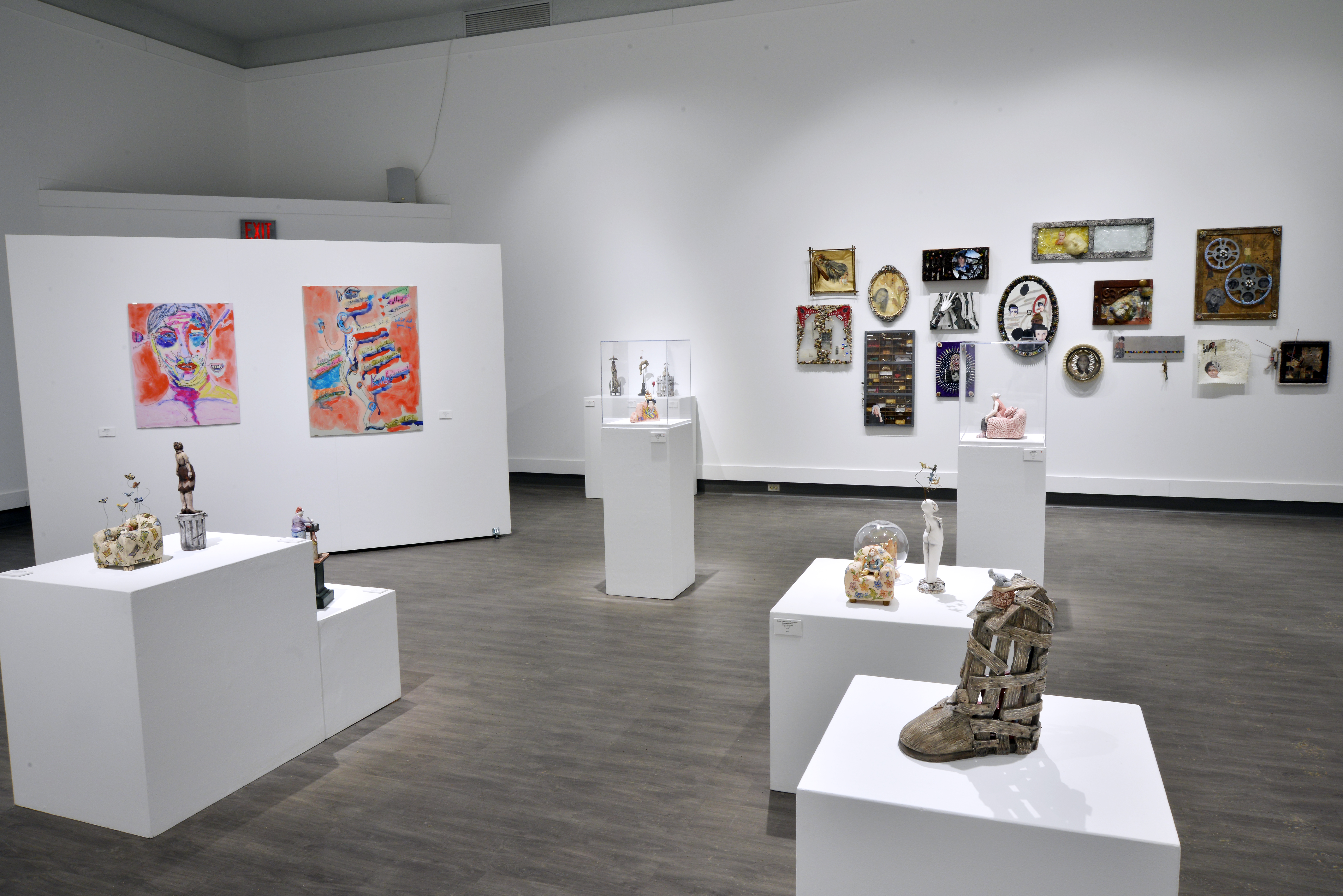 Installation view of III at Art Gallery of Regina, 2025. Photo: Don Hall.
Installation view of III at Art Gallery of Regina, 2025. Photo: Don Hall.How did you curate a “conversation” between the artists’ works without dissolving their individual voices? How did you create a conversation between each artist's work and artwork?
SM: Again, that’s one of the things I feel so privileged to do. Of course, I always consult with the artists. I tell them, “I want to curate your work in a show with this person and this person—this is what their work is like, and this is why I’d like to bring your works together.” But I also do a lot of hands-on installation myself, putting the work up in the gallery, and that’s really beneficial.
In the exhibition III, that hands-on process was particularly fun and beneficial for the overall show. As we were installing, we started with the works that went on the walls. We hung Leesa Streifler’s enormous drawings, and then, on almost the opposite side of the gallery, we placed Sheila Nourse’s assemblages. Then we brought in Deborah Potter’s sculptures.
There was this moment where one of Leesa Streifler’s drawings featured a woman wearing a pair of high-rise pink panties—you know, what we used to call “grandma panties.” Deborah had a sculpture of a woman with gray hair wearing a similar pair of pink panties. We just said, “These two women have to be looking at each other.” So we placed them deliberately to create that dialogue.
There were other instances too—moments where the subject matter created a shared experience between artists. For example, those high-waisted underwear became a kind of symbol of aging femininity—maybe even of post-menopausal sexuality, and how it changes or is perceived to diminish.
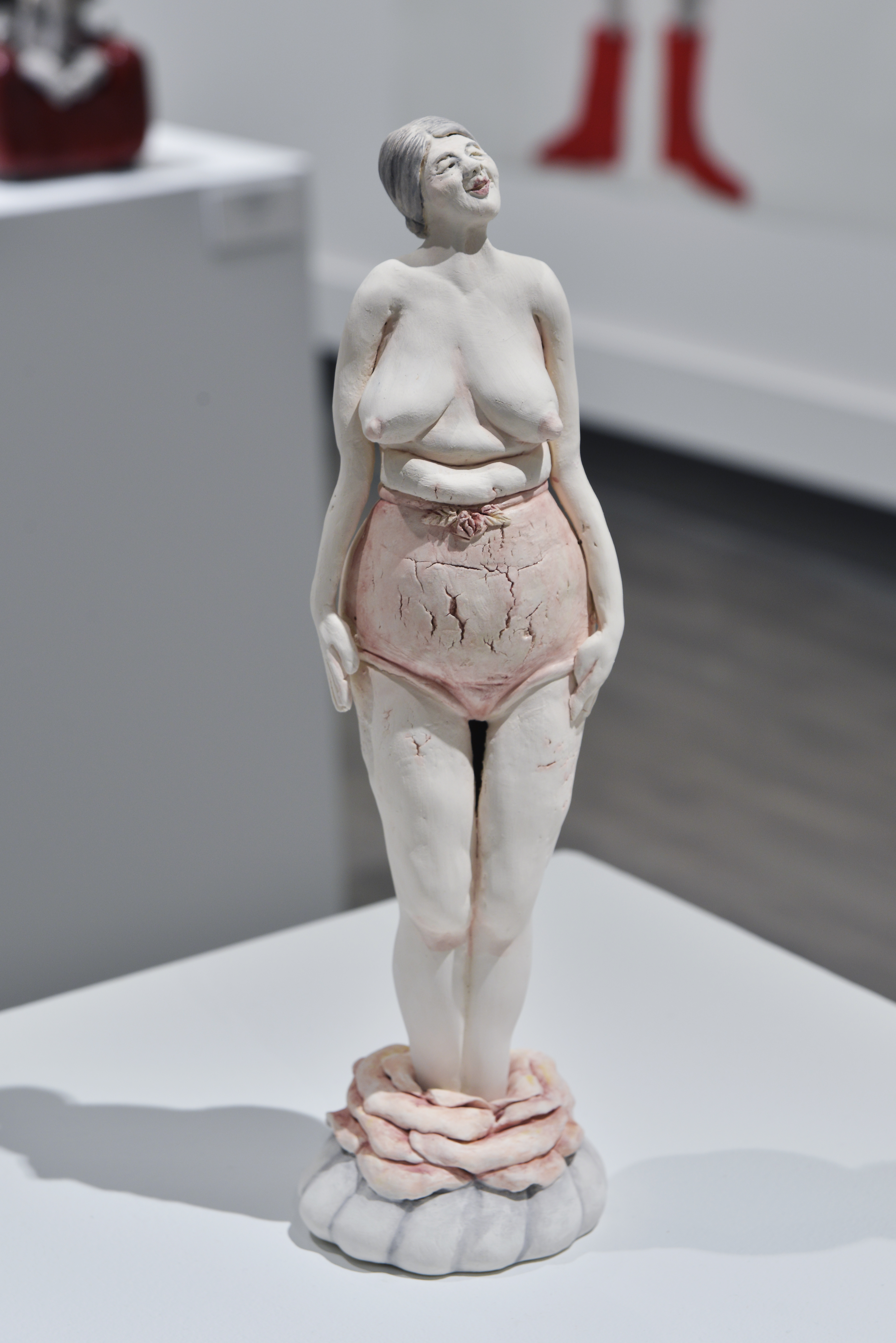
Big Girl Panties, Deborah Potter, Clay and glazes, 14"x3.5"x3.5", 2024. Photo: Don Hall.
Other conversations happened through visual elements. There was a large drawing by Leesa Streifler called Waiting, and we placed three of Deb’s sculptures nearby. They weren’t directly in front of it, but from certain angles in the gallery, you could see the sculptures—which were in dark red, orange, and gray—and they beautifully complemented the colors in Leesa Streifler’s drawing. So, color relationships also helped shape these visual conversations.
There were also material echoes. One example was a shared use of similar items—Deborah had a sculpture where the figure was wearing knitted socks, and Sheila had knitting needles in her assemblage work. It wasn’t just the literal material—it was the symbolic significance of those objects. Sometimes, one artist might present something in a way that reads as weak or vulnerable, while another presents the same symbolic item as a source of power, satisfaction, or personhood.
I think the knitting needles in Sheila’s work are a great example of that. Knitting is often seen as symbolic of an older woman—maybe someone just keeping her hands busy. It’s rarely seen as something powerful or meaningful. But Sheila stuck knitting needles through a picture frame in one of her assemblages, and I just thought it was such a funny, bold gesture. To me, it was like she was “stabbing” the picture frame—a symbol of the traditional art world, one that often excluded women and dismissed art practices considered “women’s work.”
It was humorous, but also very powerful. The picture frame traditionally says, “This is art,” and here she was, disrupting that with something associated with domesticity and craft. It really felt like a rebellious gesture—“sticking it” to the institution that devalues these forms. That’s one of the things I loved about including her work. So many people get dismissed, excluded, or diminished for so many reasons, and these pieces directly addressed that with both wit and strength.
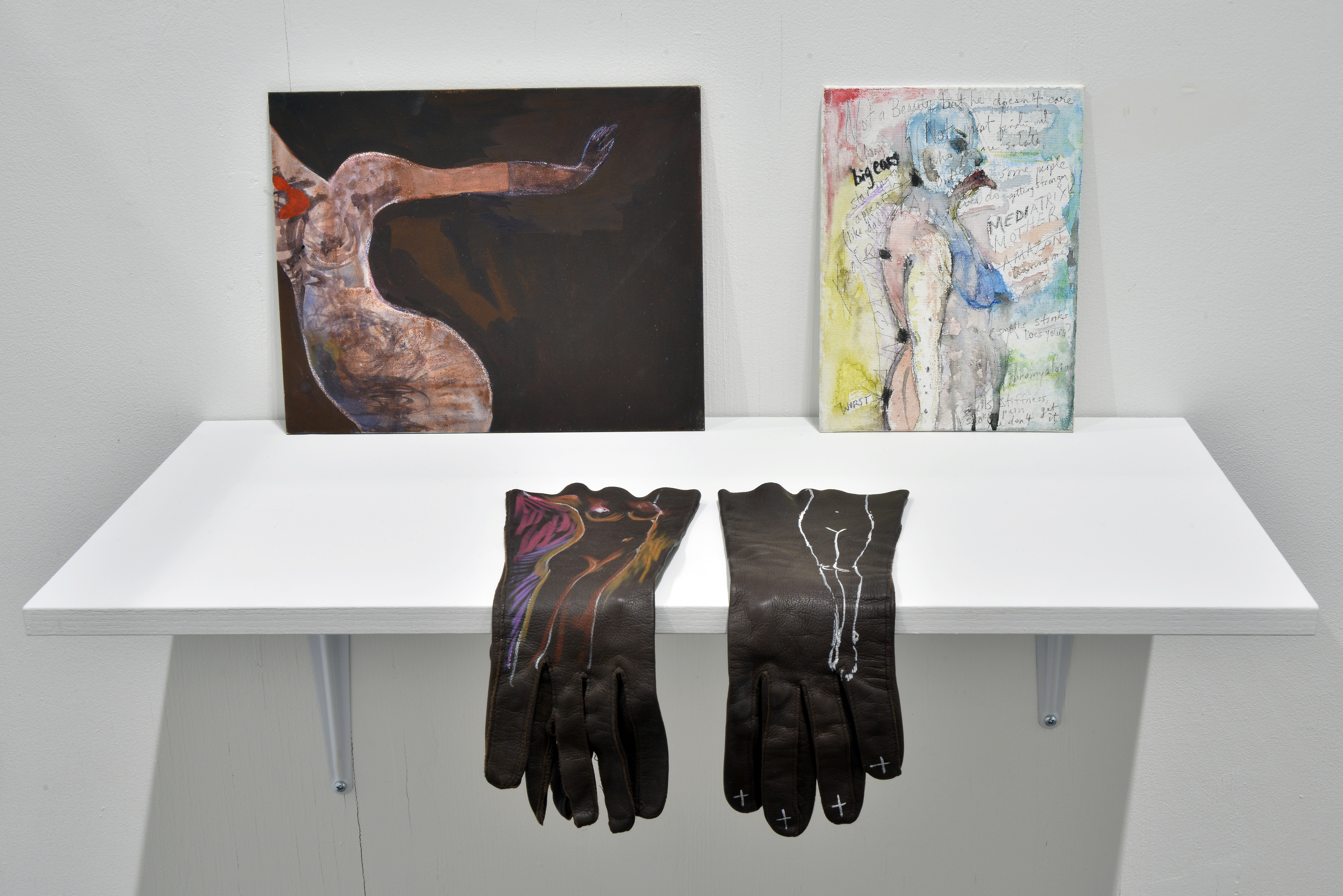 Installation view at Art Gallery of Regina. (Left to right) Stop, Leesa Streifler,Gouache and chalk on pastel board, 9"x12", 2014; Chakras, Leesa Streifler, Pen and watercolour on board, 7"x5"; Her Body, Leesa Streifler, Mixed media on vintage leather gloves, 2020. Photo: Don Hall.
Installation view at Art Gallery of Regina. (Left to right) Stop, Leesa Streifler,Gouache and chalk on pastel board, 9"x12", 2014; Chakras, Leesa Streifler, Pen and watercolour on board, 7"x5"; Her Body, Leesa Streifler, Mixed media on vintage leather gloves, 2020. Photo: Don Hall.
The artists use domestic and craft materials—ceramics, textiles, assemblage—long associated with “women’s work.” Did this material language shape your curatorial thinking in terms of reclaiming or redefining those associations?
SM: I wouldn’t say that I was specifically trying to program artists who were working in mediums that had previously been dismissed as “women’s work” or excluded from fine art because they were categorized as craft. But I am often interested in including a range of different art practices in an exhibition. I love bringing in works that might not match what people typically picture when they think of “art in an art gallery”—to challenge those preconceived notions.
Certainly, one of the things that was very satisfying for me in this exhibition was including practices that some might not immediately think of as fine art. Sheila’s assemblage work is a great example. Not only is she working in a material language that has historically been devalued, but she’s also over 65, making work about the experiences of older and elderly women. That in itself feels really innovative and, to me, challenges the status quo of what is considered “legitimate” or “high” art.
So yes, including practices like assemblage or ceramics—materials and methods that were previously excluded from galleries—was something I found very satisfying, even if it wasn’t my initial curatorial goal. These choices help expand people’s understanding of what art can be, and whose voices and materials deserve space in a gallery.
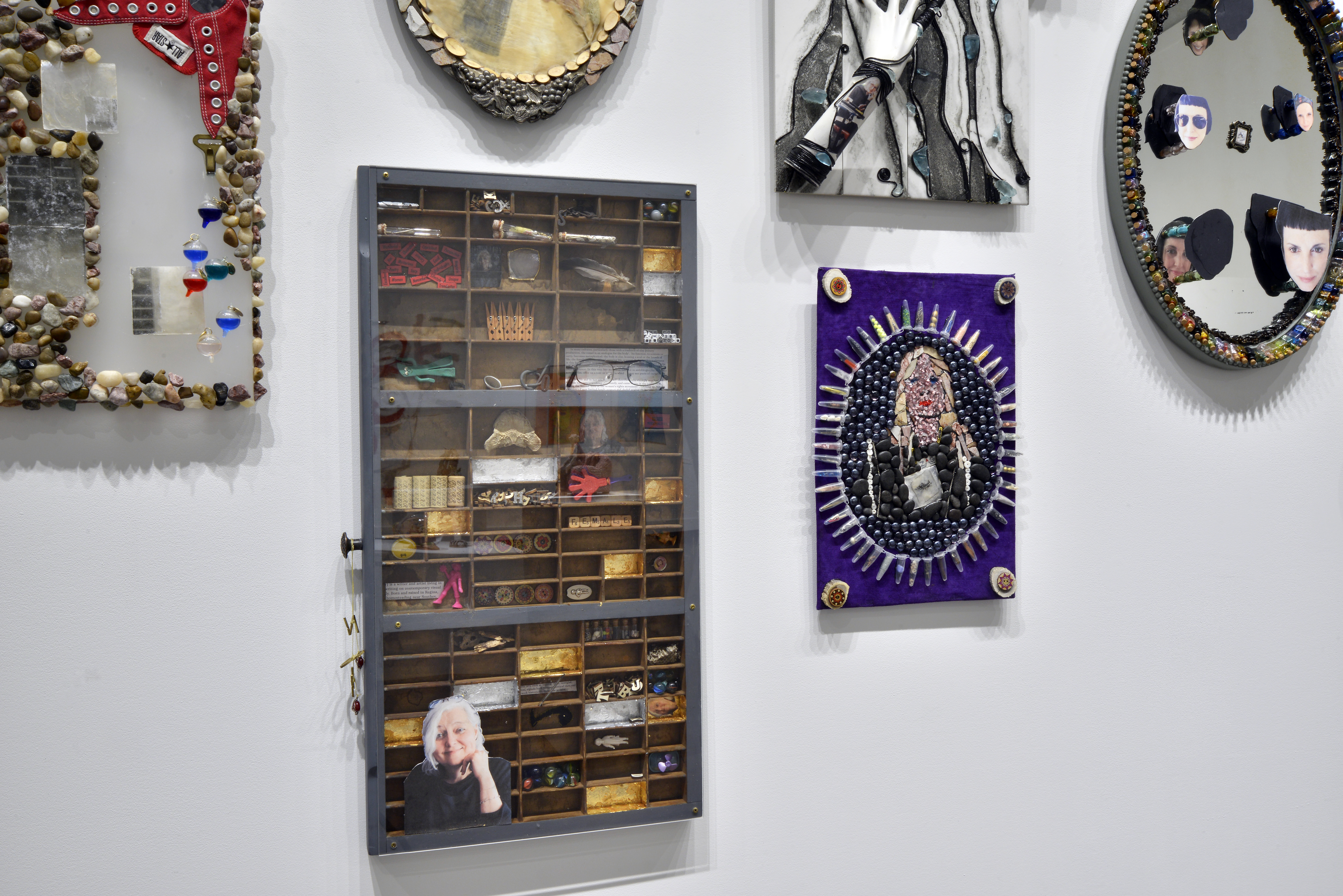 Installation view at Art Gallery of Regina. Golden Salon Series (details from left to right: Stone Path (Loretta), Treasure Hunter (Margaret), Purple Warrior (Judy), The Promise (Rae)), Sheila
Nourse, mixed media, dimensions vary, 2024. Photo: Don Hall.
Installation view at Art Gallery of Regina. Golden Salon Series (details from left to right: Stone Path (Loretta), Treasure Hunter (Margaret), Purple Warrior (Judy), The Promise (Rae)), Sheila
Nourse, mixed media, dimensions vary, 2024. Photo: Don Hall.
Assemblage seems to function as a metaphor for self-construction in life. Do you see this reassembly of broken or discarded materials as not just aesthetic, but also a political or survivalist gesture—aligned with feminist strategies of repair and resilience?
SM: I think you really hit the nail on the head there. That’s a really astute and insightful reading of assemblage as a practice. I think that’s one of the things I find so compelling about it.
Sheila’s studio is incredible—it's floor-to-ceiling shelves with bins of things that she collects, all of which she plans to use one day in her artwork. They’re all items that have been broken or discarded. So, as I mentioned before, she’s building up this portrait of a woman through the things that give her life meaning—the activities and objects that reflect her impact in the world.
But beyond that, the idea that just because something isn’t perfect, whole, or new doesn’t mean you can’t use it to build your identity—that’s really powerful. In fact, lots of people have fractures in their lives—relationship breakups, traumatic events, or other negative experiences—and all of those contribute to the whole person.
So yes, I think your interpretation is perfect. Assemblage, in this sense, isn't just aesthetic—it is also deeply political and survivalist. It aligns beautifully with feminist strategies of repair and resilience.
Deborah Potter’s figures seem to resist gendered markers. Some resemble children or men. Was this ambiguity part of your curatorial framing, and how does it complicate or expand the show’s treatment of aging as a gendered experience?
SM: I think that wasn’t really part of my curatorial framing, but more about letting the artist have their voice and express what they want. That kind of ambiguity is definitely something we see in Deb’s work very deliberately. As I mentioned before, by making these really small, miniature ceramic figurines, she’s showing us the vulnerability of the elderly.
Also, when a woman goes through menopause—when she stops menstruating, ovulating, and having children—there can be a kind of decline in sexual characteristics. So there’s often a less gendered identity associated with older people. And I think that’s part of what Deb is exploring—how aging can diminish not only gendered expression but also a person’s agency.
Some of her work comes not from her own lived experience but from witnessing her mother, father, and other family members in the later stages of life, when they may no longer be capable of doing things like dressing or feeding themselves. In that sense, they begin to resemble children again.
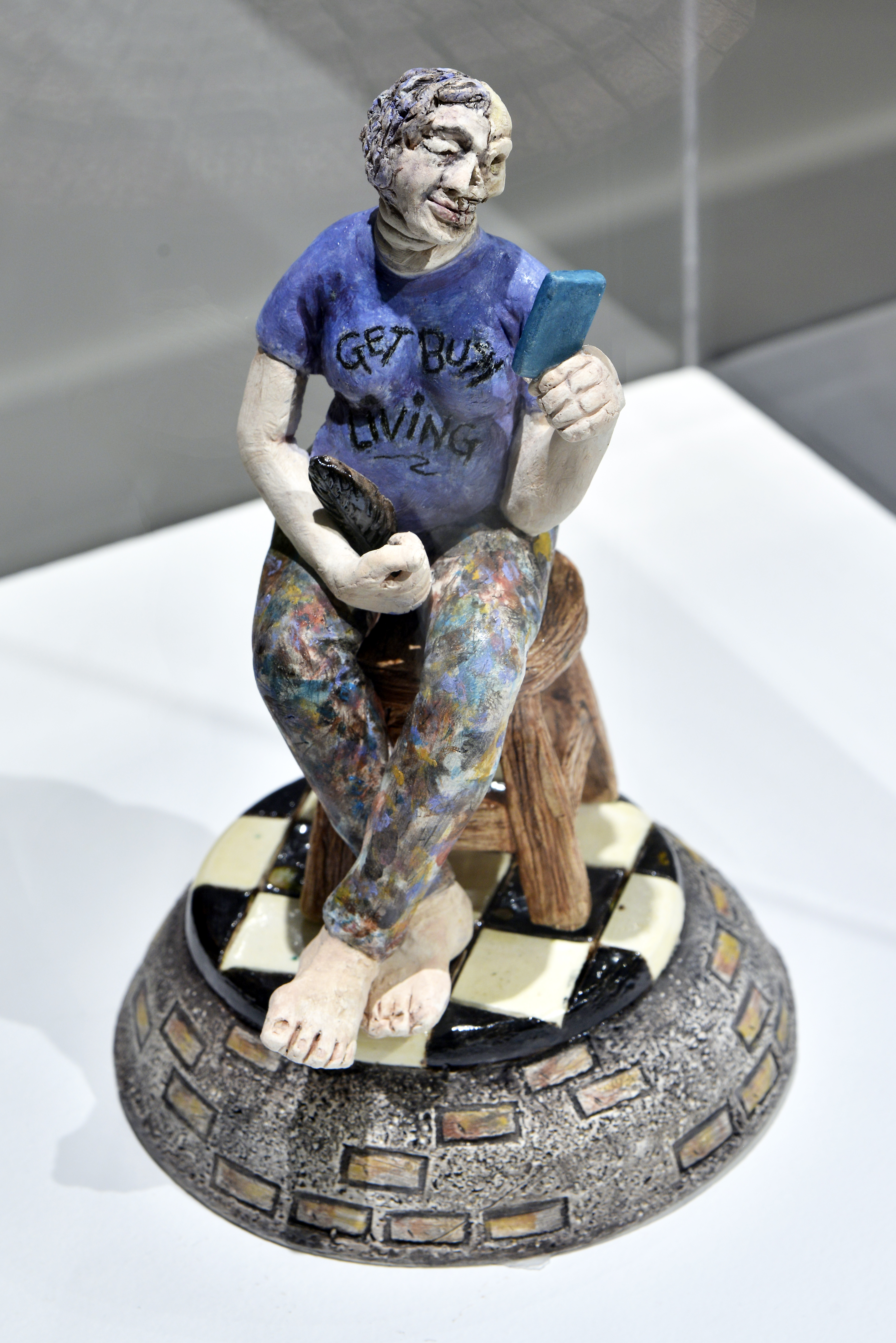
Isolated, Deborah Potter, Clay and glazes, glass cylinder, 12"x7"x7", 2024. Photo: Don Hall.
One of her pieces was very deliberately based on something she saw while visiting her mother in a care home. She looked into an empty room, and on top of the bed was a doll. That image really struck her. It offered such a profound insight into what that experience might be like for the person living in that room—seeking the kind of comfort we associate with childhood, or perhaps reliving a nurturing role by caring for the doll. It speaks to both a regression and a reclaiming of meaning in later life.
I think it's also important to note that all of the artists in the exhibition are women, and they are making work based on their own experiences. Leesa Streifler, for example, told me about one of her drawings—a portrait of her and her husband. She mentioned that this was the only man depicted in the exhibition. But even then, she titled the work to reflect that he is sort of an appendage to the woman, reversing the usual societal framing of couples where the male partner is often seen as the central figure.
The image itself isn’t overtly romantic, but it conveys something very tender and moving—a sense that they are in it together. That shared experience, rather than traditional gender roles, is what really comes through.
 Installation view at Art Gallery of Regina. (Clockwise from top left) Old Bird, Deborah Potter, Clay and glazes, 16"x5"x3.5", 2024; Freedom 55, Deborah Potter, Clay and glaze, found object, 15.5"x7"x6", 2024; Invisible II, Deborah Potter, Clay, glazes, 6 x 6 x 7”, 2024. Photo: Don Hall.
Installation view at Art Gallery of Regina. (Clockwise from top left) Old Bird, Deborah Potter, Clay and glazes, 16"x5"x3.5", 2024; Freedom 55, Deborah Potter, Clay and glaze, found object, 15.5"x7"x6", 2024; Invisible II, Deborah Potter, Clay, glazes, 6 x 6 x 7”, 2024. Photo: Don Hall.
Leesa Streifler’s large-scale works seem to reclaim space for aging women’s experiences. Can we read this as a counterpoint to Deborah’s miniatures—a tension between shrinking and expanding presence?
SM: I think certainly, as we’ve talked about before, scale plays an important role. Leesa Streifler is making these women oversized—making us notice them, making us maybe recognize that they have power. While Deb’s sculptures are tiny and made of ceramic, and some of them explore a loss of independence or agency, I wouldn’t exactly call them counterpoints. But yes, they do offer different perspectives—either on how we view older and aging people, or even how aging individuals view themselves.
That contrast in scale and tone adds richness to the exhibition. As I said before, I think Leesa Streifler’s work—with its humor and sheer visual beauty—is incredibly inspiring and uplifting. It expands the way we understand aging, especially for women, and invites us to see strength and presence where society might expect invisibility.
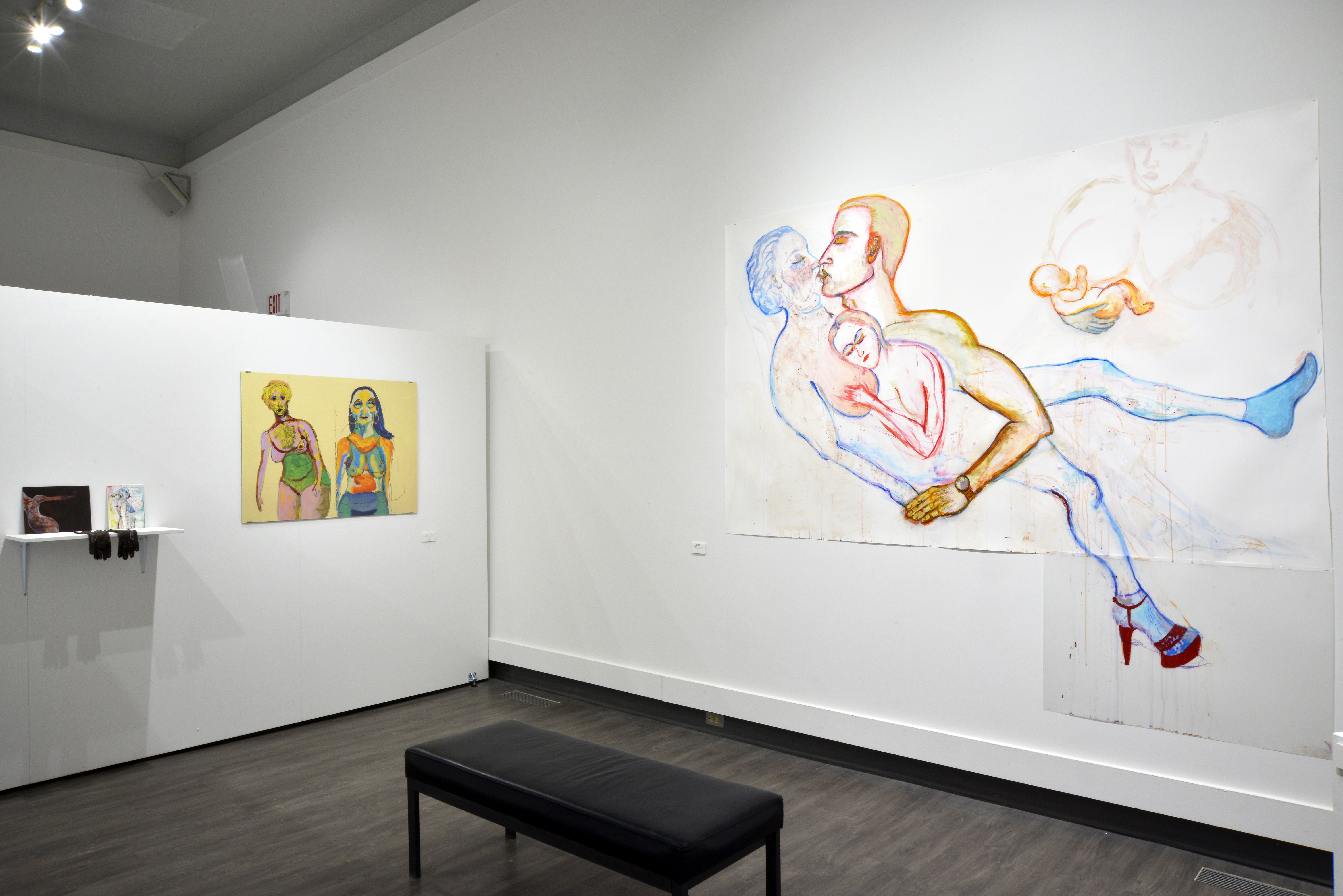 Installation view at Art Gallery of Regina. (Left to right) Stop, Leesa Streifler,Gouache and chalk on pastel board, 9"x12", 2014; Chakras, Leesa Streifler, Pen and watercolour on board, 7"x5"; Her Body, Leesa Streifler, Mixed media on vintage leather gloves, 2020; Old Friends, Leesa
Streifler, digital print on aluminum, 30 x 40", 2024; Her Dream, Leesa Streifler, Oilstick and
Installation view at Art Gallery of Regina. (Left to right) Stop, Leesa Streifler,Gouache and chalk on pastel board, 9"x12", 2014; Chakras, Leesa Streifler, Pen and watercolour on board, 7"x5"; Her Body, Leesa Streifler, Mixed media on vintage leather gloves, 2020; Old Friends, Leesa
Streifler, digital print on aluminum, 30 x 40", 2024; Her Dream, Leesa Streifler, Oilstick and
acrylic on mylar, 96"x40" plus 22"x30", 2024. Photo: Don Hall.
Leesa Streifler’s work engages with fantasy and desire—topics often erased from depictions of older women. How important was it for you to foreground aging not as an endpoint but as a continuation of longing, imagination, and erotic life?
SM: I would say again that I’m really led by the artists and what they bring forward in their work. And I think this idea—of fantasy and eroticism in later life—is really important to Leesa Streifler and is central to how she approaches her practice. It's something that’s so often unacknowledged: that older women can still experience desire, can still engage in fantasy, and can absolutely still be erotic figures.
One of her drawings, Her Dream, is a beautiful example. Leesa Streifler often creates these composite bodies—figures made up of many layered selves and relationships—so it’s never just one static person. In this work, we see an elderly woman with a pale, soft body, and there’s the profile of a strong, muscular man—handsome, idealized—his lips pressed to hers. Between them, sprouting from her abdomen, is a child nursing at her breast. It’s a powerful and complex image. It speaks to physical connection, yes, but also to desire and longing, and how these emotions remain present throughout life.
It opens up the idea that desire doesn’t have to be narrowly defined—it’s not just about sexuality in the conventional sense. Leesa Streifler invites us to consider a broader spectrum of pleasure. Even something like nursing a child—typically removed from conversations about sexuality—can coexist with intimacy and longing in this work. That kind of complexity, where emotional, physical, and relational forms of connection all intersect, is something she handles beautifully.
As a feminist artist, Leesa Streifler has long explored how women are seen and judged—especially through the lens of physical appearance and youthfulness. Even now, there’s a disproportionate societal pressure on women to be attractive in specific ways, and aging can feel disempowering when you’re no longer seen as fitting that ideal. This pressure is still very present in Canadian society, and many women struggle with it deeply.
As we age, our physical selves change, and that shift can be unsettling—especially if your sense of identity has been tied closely to how you look. Leesa Streifler’s work challenges that. It pushes against those narrow definitions and opens up space to see aging not as an endpoint, but as a continuation—of imagination, of desire, and of richly lived experience.
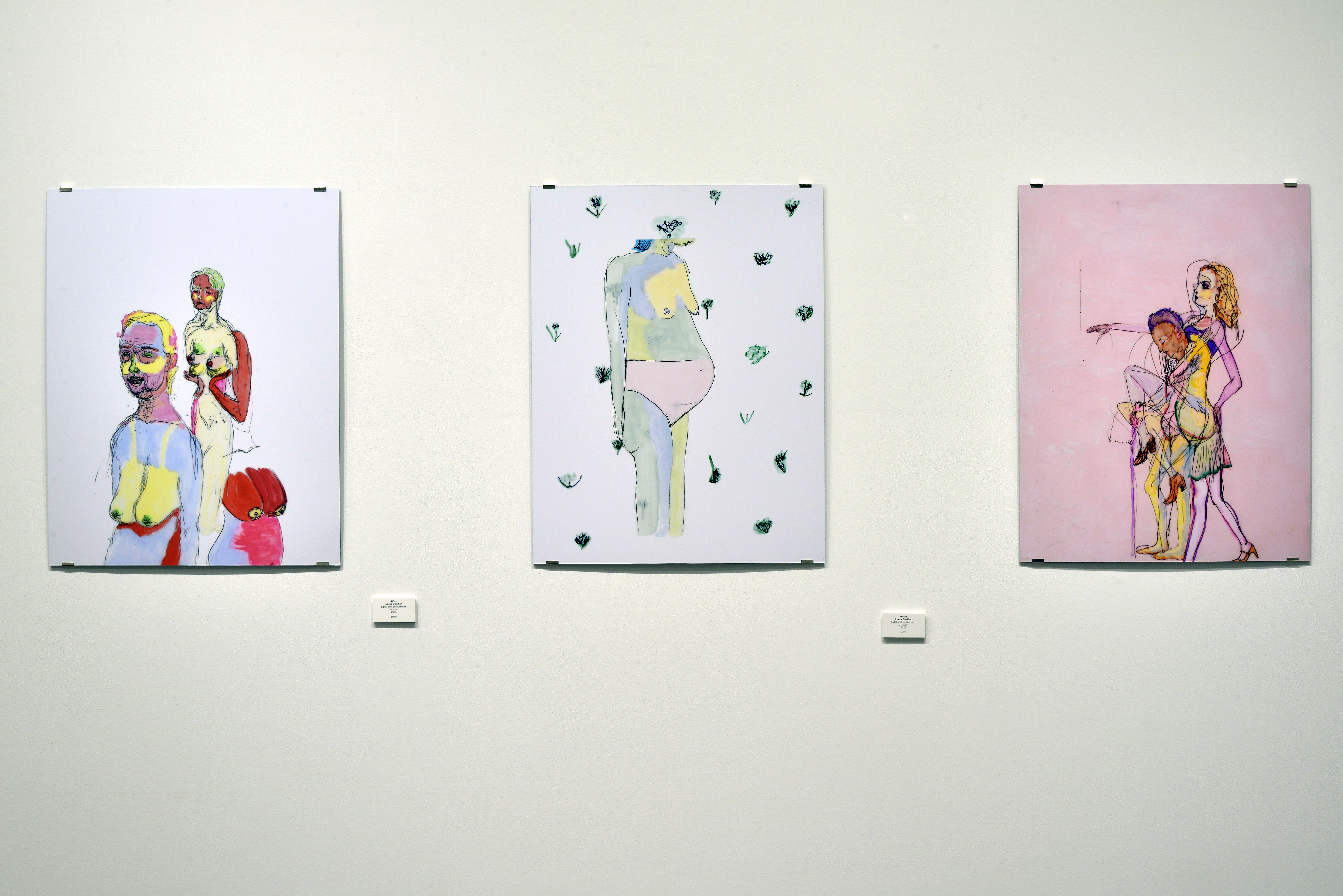 Installation view at Art Gallery of Regina. (Left) Affect, Leesa Streifler, digital print on aluminum,
31 x 24", 2023; (Centre) Secure, Leesa Streifler, digital print on aluminum, 31 x 24", 2023. (Right) Untitled (pink dancer), Leesa Streifler, digital print on aluminum, 31 x 24", 2025. Photo:
Don Hall.
Installation view at Art Gallery of Regina. (Left) Affect, Leesa Streifler, digital print on aluminum,
31 x 24", 2023; (Centre) Secure, Leesa Streifler, digital print on aluminum, 31 x 24", 2023. (Right) Untitled (pink dancer), Leesa Streifler, digital print on aluminum, 31 x 24", 2025. Photo:
Don Hall.
Leesa Streifler’s work treats aging as an unfolding narrative, while Deborah’s sculptures feel suspended in time. How do these contrasting temporalities speak to each other within the exhibition?
SM: I think that’s a really beautiful way to frame it—Leesa Streifler’s work as an unfolding narrative and Deborah’s sculptures as suspended in time. That contrast absolutely came through in the exhibition.
Leesa Streifler is very interested in the grotesque, in challenging our expectations of beauty and desirability. Her figures often have multiple limbs or heads—bodies that are exaggerated or hybrid. But this distortion isn’t arbitrary; it’s a way for her to stitch together the past and the present selves of a person. She’s showing us the fullness of a life lived across time. One of her works in the show is called Overtime, and it’s literally split down the middle—one half depicts a little girl, the other a woman. It really captures that sense of a self unfolding through time, looking both backward into childhood and forward into aging.
Deborah’s work, on the other hand, is much more about capturing a single, poignant moment. There’s a stillness to her sculptures, a kind of emotional suspension. Especially the ones encased in these clear resin bubbles—those feel like time capsules, holding onto something fragile and fleeting. And then she renders them in ceramic, a medium that can last for centuries. That act of preservation—of holding on to a moment that might otherwise be lost—is really moving.
There’s also a difference in how each artist works. Deborah’s pieces are often based on very specific people or scenes—something she saw, or someone she knew.Leesa Streifler, by contrast, works entirely from her imagination. She doesn’t use models or photographs. She draws on her own observations—her body, her husband’s, her child’s—but she transforms those into these expansive, surreal images. That openness gives her work a much wider narrative scope, almost mythic in scale, whereas Deborah’s work is rooted in very real, intimate vignettes.
Together, these different temporalities speak to the richness of aging—not just as a biological process, but as something experienced emotionally, imaginatively, and relationally. Leesa Streifler gives us the arc of a life; Deborah gives us a moment suspended within it. I think those perspectives really complement each other.
 Installation view at Art Gallery of Regina. (Left) Improvement, Leesa Streifler
digital print on aluminum, 31 x 24", 2024; (Right) Common Signs, Leesa Streifler, digital print on aluminum, 40 x 30", 2024. Photo: Don Hall.
Installation view at Art Gallery of Regina. (Left) Improvement, Leesa Streifler
digital print on aluminum, 31 x 24", 2024; (Right) Common Signs, Leesa Streifler, digital print on aluminum, 40 x 30", 2024. Photo: Don Hall.
You mentioned that the exhibition resists dominant cultural narratives of aging. Yet the absence of family or intergenerational relationships is striking. Do you see the focus on the individual aging subject as a rejection of traditional roles, such as motherhood or grandmotherhood?
SM: That’s a really profound observation. I don’t think the absence of family or support networks in the works is a rejection of traditional roles, but rather a reflection of a social reality—especially in Canada. As people age, they often become increasingly isolated. After retirement, they may lose a core part of their daily social life. If mobility declines, it becomes harder to maintain friendships or even leave the house.
Unlike in many other cultures, multigenerational living isn’t common in Canada. So, many elderly people live alone, and that isolation becomes a defining aspect of their experience. You can really see that in both Deb and Leesa Streifler’s work. In Leesa Streifler’s drawings, the figures often float against a blank background—no home, no room, no specific setting. There’s a sense of disconnection. Deborah’s sculptures also reflect this. The presence of a single armchair, for example, becomes such a powerful symbol—a whole world reduced to one piece of furniture. That’s where you sit, eat, watch TV, look out the window. It becomes the center of life for someone whose world has shrunk.
So I think what we’re seeing isn’t a rejection of motherhood or grandmotherhood, but an acknowledgment that, in reality, many elderly people in Canada live outside of those relational roles, or at least outside the structures that used to support them.
There are moments in the show that break from this solitude—like Leesa Streifler’s portrait of herself and her husband. That piece is especially moving because it's rare in the exhibition to see two people together. It feels intimate, like an interdependent unit, quietly resisting that narrative of isolation.
We’re also facing a demographic shift in Canada: our population is aging, and there’s increasing reliance on retirement homes and care facilities. Living with family is no longer the norm. And even when we try to change that—like offering our parents a place in our homes—they may refuse because they don’t want to be a burden. Sometimes that stems from their own experiences of caregiving, and a desire not to impose on the next generation. I’d really love to see a cultural shift in how we think about aging and interdependence.
H: Thank you so much for your thoughtful responses. I’ve learned a great deal through this conversation. If you have any final thoughts to share, I’d love to hear them.
SM: No, I just really appreciate your insights, and I hope you’ll share what resonated with you about the exhibition. That’s what I hope for—that it sparks reflection.
H: Honestly, I felt the isolation so strongly. That individual experience of aging you described—it echoed something I’ve been feeling here too. Where I come from, everything is family-centered. Elder care homes are not accepted in my culture. But living here, in this different context, I find myself in a kind of solitary existence that’s new to me. Like you said, the armchair becomes your whole world. I felt deeply connected to the artworks, even as a younger person. It made me realize how close we all can come to living like the elderly—physically, emotionally, socially—even before we age.
SM: That’s such a beautiful and meaningful observation, Hooria. Exactly. I think we’re all experiencing a kind of premature aging in how we live now—especially with subscription streaming and delivery services. It’s like the world is encouraging us never to leave our homes. Your reflection really captures the emotional core of the exhibition.
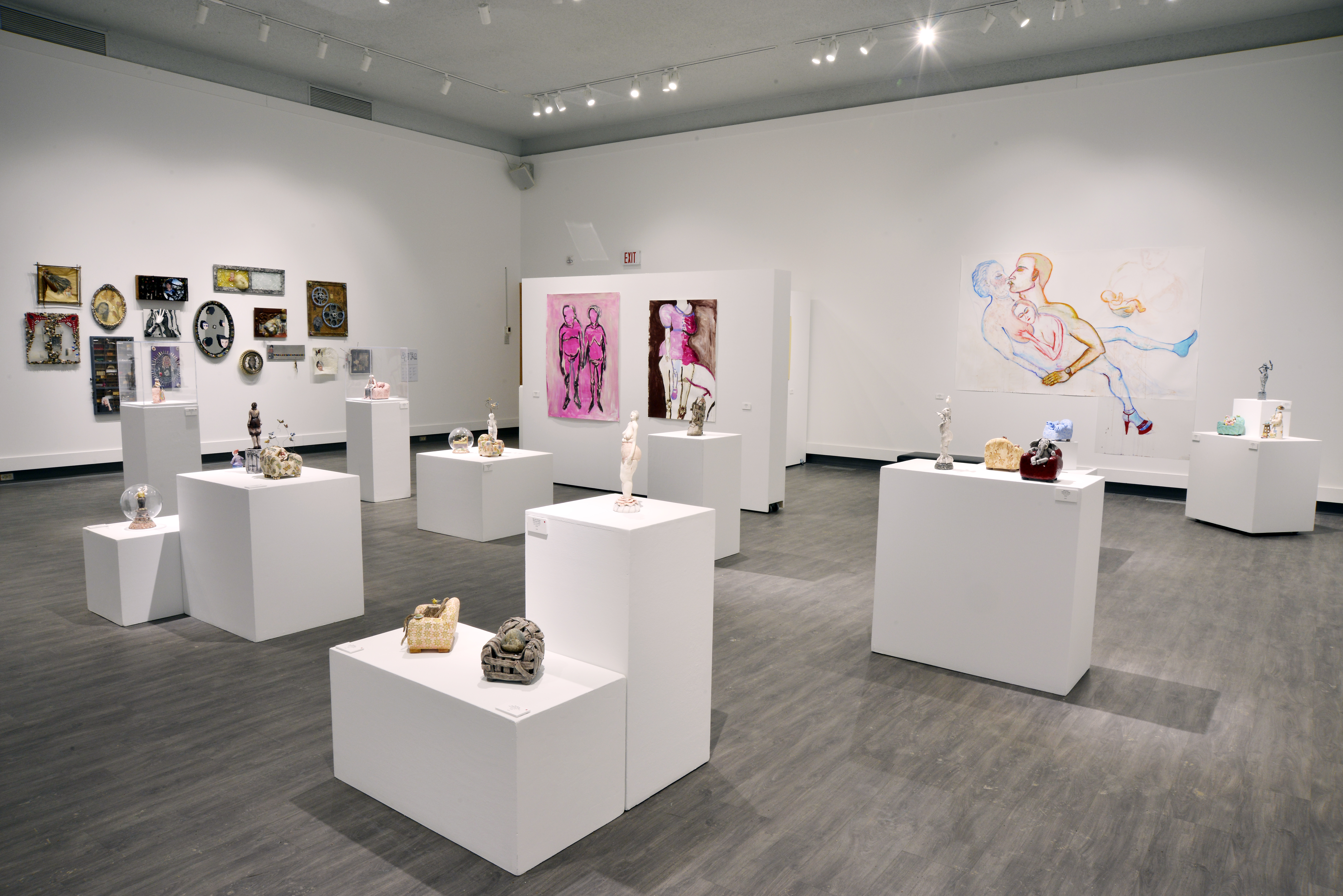 Installation view of III at Art Gallery of Regina, 2025. Photo: Don Hall.
Installation view of III at Art Gallery of Regina, 2025. Photo: Don Hall._________________________________
Sandee Moore is a white, settler, cis-woman who proposes to animate social relationships through personal exchange via artwork in media such as performance, video, installation, and interactive electronic sculpture. Moore has screened and exhibited across Canada (including The Surrey Art Gallery, The Art Gallery of Alberta, Plug In ICA, The Winnipeg Art Gallery, The Dalhousie Art Gallery, The Blackwood Gallery, and The Dunlop Art Gallery) and in Japan.
She earned her B.F.A. (Honours) from The University of Victoria and M.FA. in Intermedia from The University of Regina. She has worked as an arts administrator, writer and university instructor, and regularly publishes her art criticism and scholarly texts in various books, periodicals and newspapers. Moore currently makes her home on Treaty 4 Lands in Regina, SK, where she is employed as Director/Curator at the Art Gallery of Regina.
Hooria Rajabzadeh is an Iranian lens-based artist whose practice primarily explores gender and gender imbalances at the intersection of culture and race, often drawing on her own and other Iranian women’s lived experiences. She holds a Bachelor’s and a Master’s degree in Photography from the University of Tehran, as well as a second Master’s degree in Visual Arts from the University of Regina. She is currently working as a Community Art Consultant at the City of Regina.
